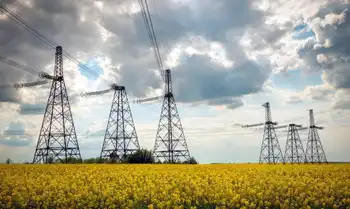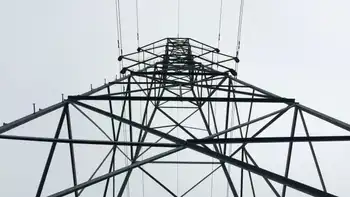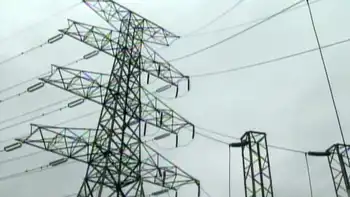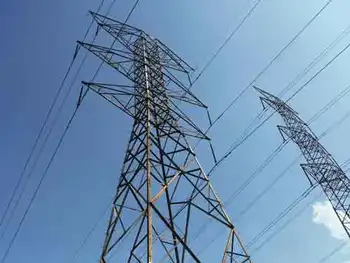Wind farm in Lempster is nearly ready to go
And not a moment too soon, said Gary Long, president of Public Service of New Hampshire, whose company will buy 90 percent of the turbines' electricity to help it meet government mandates for renewable energy.
"We need a lot more of this," Long said.He was one of a dozen officials and residents of the tiny town of Lempster who showed up at Lempster's elementary school to get a look at the almost-completed Lempster Wind project, New Hampshire's first wind farm.
The 24-megawatt installation, about two hours northwest of Nashua, will produce enough electricity to power roughly 10,000 homes a year.
Lempster Wind was built and funded by Spanish energy giant Iberdrola Renewables, which has built and operates 8,000 megawatts worth of wind projects around the world, enough to power all of New Hampshire several times over. It was supposed to have been finished in late summer, but delays in the delivery of various components held it up, officials said.
Iberdrola officials declined to give the cost of the project, but indicated that it was around the industry average of $2 million per megawatt, or about $48 million. That includes the cost of upgrading some 10 miles of electric lines along Route 10, carrying the wind farm's power to a substation in Newport.
New Hampshire Electric Cooperative, which got its start in Lempster in 1939, will buy the remaining 10 percent of Lempster Wind's output. The project will also allow utilities to buy some of the renewable energy certificates, or RECs, that they need to meet state mandates.
All 12 of the project's 240-foot-tall towers have been erected along the Lempster Mountain ridgeline, and most of them have their 70-ton gearboxes and trio of 139-foot-long rotor blades installed. Ironically, work on further installation had to halt Tuesday because it was too windy for the cranes to operate safely.
Lempster, which has about 1,000 people, should profit from the project, which is expected to raise its total tax base from about $117 million to around $150 million, Thurber said. The town and state are still negotiating with Iberdrola about the exact amount of payments it will make.
"We have a love-hate relationship with them.... Some people think it spoils the ridgeline," said Lempster Selectman Ed Everett Thurber.
Concern about appearance, and about the effect of the large construction work stretching along about five miles of ridgeline, led several landowners in and around Lempster to file opposition to the project after it was proposed, some four years ago.
Thurber said his only concern was how the turbines would sound when they start spinning.
One big fan is Kevin Onnela, who owns the land where 10 of the 12 turbines are located. His mountain-top home once got all its electricity from a small windmill in his yard, he said, so he was happy to enter into the 30-year lease agreement with Iberdrola.
"There have been a lot of local people employed with this project," he said. "I'd hate to guess how many millions of dollars this project has injected in our community."
About 120 people were working at the construction site at its maximum, said Edward Cherian, development director for Iberdrola Renewables in New England. Three or four people will work at the site for operations and maintenance.
New Hampshire was early to wind-power research: A series of small windmills atop Crotched Mountain in the late 1970s may have been the first concentrated wind power research project in the country.
But it has done little since, and is late to utility-scale wind power. Vermont, Maine and Massachusetts all have operating wind farms, although in none of those states does wind meet even one percent of total electricity needs.
It seems likely that the biggest wind projects in the Northeast will be located several miles offshore, where winds are steadier and there is less opposition from neighbors.
Rhode Island, Delaware and New Jersey are all pursing studies on offshore wind farms that would be 10 to 20 times as big as Lempster Wind, and Massachusetts has been wrestling for years with environmental opposition to a huge proposed wind farm between Cape Cod and Nantucket.
In New Hampshire, the next wind farm is likely to be in the North Country. Connecticut-based Nobel Environmental is proposing to build one in Coos County, near Groveton, that would be four times the size of Lempster Wind.
It faces a different obstacle: Its 99-megawatt capacity would use up all the excess capacity for power lines carrying energy down from North of the Notches, leaving nothing for several proposed wood-burning power plants unless some $200 million worth of upgrades are made to the electrical grid.
This fact has led to opposition from some Groveton-area residents, who would prefer wood-burning plants because they generate many more jobs.
No matter what happens there, however, Lempster Wind will stand alone in New Hampshire for years.
"It's kind of a tourist attraction," said state Sen. Bob Odell, who lives in Lempster. "I had visitors come over from south of Claremont, to see the windmills."
Wind isnÂ’t the only source of electricity that offers an alternative to polluting fuels like coal and oil, but thereÂ’s no easy way for New Hampshire to expand other ones. HereÂ’s a look at some of prospects of alternative energy sources in the state.
Solar: New England’s weather isn’t very good for cheap solar power, which is why the big solar-power proposals are in the American Southwest. The only large site in N.H. is a 50-kilowatt installation at the Stonyfield Farms plant in Londonderry, which produces a few percent of that factory’s electricity. More than 100 private homes have solar panels and participate in the state’s “net metering” program, under which they can sell excess electricity back to the utility.
Biomass: Burning wood to create steam that powers turbines is generally considered the stateÂ’s best alternative-power option. In 2006, according to the Department of Energy, New Hampshire produced almost 2 percent of all the biomass electricity in the country, from a half-dozen relatively small power plants, usually with less than 25 megawatts production, in the central and northern part of the state. Most notably, PSNH converted a third of its coal-powered Schiller Station power plant in Portsmouth to wood. Proposals have been floated to create at least a half-dozen other biomass plants in the North Country, but most are stymied by a shortage of power lines to carry the electricity to cities.
Nuclear: Seabrook Station generates enough electricity each year to power about half of N.H.Â’s needs, although much is sold out of state. When first proposed, Seabrook was going to have two reactors, but the second one was scuttled due to cost. While some people have mentioned the possibility of building a second reactor, there are no plans to do so. New Brunswick, Canada, is proposing a huge second reactor at its Port Lepreau nuclear plant, not far from the Maine border, largely so it could sell the electricity to the U.S.
Hydropower: About 7 percent of the electricity in N.H. is generated by hydropower dams, most prominently the Amoskeag Dam in Manchester. No proposals are on the table for new dams, however, largely because of environmental concerns and lack of new sites. Quebec plans to build a huge hydroelectric project north of Montreal, largely to make electricity to sell to the U.S.
Other: A 2007 MIT study said the Conway area might be suitable for large-scale geothermal power, in which high-temperature rock from miles underground is tapped to power a steam turbine. Other sites out West are much more suitable, however. Two companies have the rights to study tidal power in and around the Great Bay, but no plans have been announced. No tidal power plants of any importance exist in this country.
Related News

Cleaning up Canada's electricity is critical to meeting climate pledges
TORONTO - A new tool has been proposed in the federal election campaign as a way of eradicating the carbon emissions from Canada’s patchwork electricity system.
As the country’s need for power grows through the decarbonization of transportation, industry and space heating, the Liberal Party climate plan is proposing a clean energy standard to help Canada achieve a 100% net-zero-electricity system by 2035.
The proposal echoes a report released August 19 by the David Suzuki Foundation and a group of environmental NGOs that also calls for a clean electricity standard, capping power-sector emissions, and tighter carbon-pricing regulations. The report, written by Simon…





